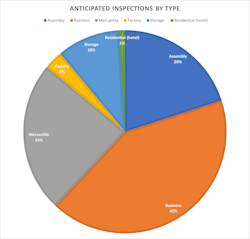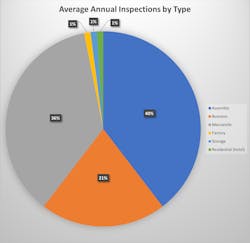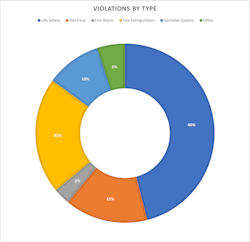Fire Inspection Program Management: Are You Efficient and Effective?
A hard truth in 2023: Unless you are located in California, Texas or the Southeast, your fire department probably isn’t growing. Your workload might be getting larger, but your human and physical resources to handle that workload isn’t.
Recognizing this truth, it’s crucial for fire service managers to understand the importance of program management and performance measurement. These tools allow managers to demonstrate how they are—or aren’t—meeting organizational performance goals.
What are those organizational goals? Some fire departments name general goals in a mission statement—“Protect life and property”—which works as a statement of purpose, but this article concerns measuring progress. This is accomplished via defined and measurable objectives. As I often say to fire chiefs, “Goals are for your Facebook wall. Objectives are a prompt toward meaningful action.”
However you choose to say it, reducing the frequency and severity of emergency calls for service is job one in your department regardless of size or location. To say, believe or act otherwise in a 21st century public safety context is regressive and unhelpful.
How does a department define and measure objectives toward that goal in the context of fire code enforcement? Just as importantly, how does a department achieve that goal with less time and fewer people? My department and many others decided to create processes and objectives that allow us to maximize limited resources toward accomplishing our code enforcement goal.
Where are you starting from?
What does your organization do right now? If you aren’t meeting your own expectations, how do you solve that problem?
Hopefully, your organization has some kind of fire inspection program—although a little more than half of all U.S. citizens live in places in which the fire department doesn’t. If the department doesn’t have an inspection program or performs fire inspections without any structure, NFPA provides guidance in the form of NFPA 1730: Standard on Organization and Deployment of Fire Prevention Inspection and Code Enforcement, Plan Review, Investigation, and Public Education Operations. Importantly, Section 4.6.1 states that the fire prevention organization shall conduct a community risk assessment (CRA). Chapter 5 outlines the demographic and response information that’s needed to conduct a valid risk assessment.
Since fire code enforcement is a foundational piece of any community risk reduction (CRR) program, your community’s demographic and building stock information yields valuable insights into how your department should use available resources to implement a fire inspection program. The CRA helps to drive the inspection program; for our purposes, that point is reinforced in Section 6.3.2 of NFPA 1730, which states that fire inspection and code enforcement shall be conducted.
Once a department knows what it should do via the guidance of codes, standards and its CRA, decisions should be made about how to achieve that goal. Again, measurable objectives are used to meet specific goals and, in this case, are informed by the community’s composition, the department’s expectation for the program and past practice.
Community composition. To paraphrase an old song, who are the people in your neighborhood? What do they do, in what sorts of structures do they do it and how do hazards that are associated with their activities contribute to community risk? Risk—and code enforcement—look very different in an office park, a mercantile district and a factory.
What are the frequency and severity of structure fires in your commercial environment?
Department expectations. What exactly are the goals of your fire code inspection program? According to the Johns Hopkins Center for Injury Research & Policy’s survey, "Prevention Activities in U.S. Fire Departments,” 62.7 percent of fire department respondents don’t evaluate their fire prevention program. This includes the efficacy of the fire code inspection program, which we will explore below.
Past practice. If your department performed code enforcement before, how did it provide the service? Is your community small enough that it’s possible to inspect every commercial occupancy annually? If not, the department must use the risk assessment to create priorities. What worked before doesn’t always work today.
Another important question deals with follow-through: Is your organization a let’s-check-the-box/one-time-site-visit department, or does it focus on a smaller number of inspections, which it sees through to full compliance? From the efficacy standpoint, the latter is preferable. To perform a fire inspection but not follow up on violations undermines the credibility of the inspector, the department and the fire code inspection program.
Planning the work
When my department decided that it needed to define performance objectives for the fire code enforcement program and that it needed a system in support of those objectives, the first step was to determine what types of occupancies are in the department’s service area.
According to our records management system, my city (Champaign, IL) has approximately 2,410 commercial occupancies.
Past practice stated the hope that inspection staff would visit each commercial occupancy, which was an achievable goal when it was formed 30 years ago—when the city was about half of its current size.
The city grew, and the commercial base grew, but the fire code inspection staff didn’t. (These personnel are also responsible for fire investigation and fire and life-safety education, which creates further demands on limited time.) Based on the findings of my department’s first CRA, which was conducted in 2019, it decided that both the frequency and efficacy of fire code inspection needed to improve, which led to the creation of Standing Order 5001.3, “Fire Code Inspection and Enforcement.”A step further
Next, with an eye toward more efficacious fire code enforcement, the department looked at what types of fire code violations it encountered most (Chart 3), so it could tailor the “teaching” aspect of fire inspection toward those conditions.
Inspectors found an average of 2.07 violations per inspection, with 11 as the maximum number of violations that were found in a single inspection.Why examine the types of violations that were found? One quarter of the workload of our department’s inspectors comes via referrals from members on the street. (There are more firefighters than there are inspectors, and firefighters have eyes on a wide variety of buildings.)
The enforcement of the fire code focuses on providing the safest environment for the most people. By teaching firefighters which violations occur the most, they can function as better informed “eyes” for fire inspectors.
In my city’s case, most violations deal with how people escape from a fire and their ability to fight the fire themselves—both significant safety issues. As a whole and compared with the proposed best practice, if the department focuses on egress and fire protection components of assembly, business, and mercantile occupancies, fire inspectors will be in a better position to be effective (meeting the stated objectives of the program) and efficacious (providing the most valuable service to the greatest number of people).
Pick your battles
An overtasked, underresourced fire prevention group is common in U.S. fire departments. Because of this, there tends to be a shared attitude of resignation about the limits of the effectiveness of a fire code inspection program. That doesn’t have to be the case. As CRR and fire prevention advocates, we are professionally—and, I believe, ethically—obligated to seek the best bang for the buck. We can accomplish this by leveraging new tools, such as risk assessment, data analysis and remote video inspection. This allows us to maximize the capability and effectiveness of time-pressed fire prevention personnel, to correct the violations that affect citizen customers the most, in the buildings that they occupy the most.
We can’t be everywhere, and we can’t put more hands on the line. Accepting this, we must make intelligent decisions about what actions best move us toward the fire service’s primary goal: reducing the frequency and severity of emergency calls for service. In my department, we achieved goals that address lowering our fire fatality rate and reducing our average dollar loss per structure fire, which bodes well for the effectiveness and efficacy of our new code enforcement methodology.
About the Author

Jeremy Mitchell
A 24-year veteran of the fire service and EMS, Jeremy Mitchell serves as the deputy fire marshal of the Champaign, IL, Fire Department. He is a certified Fire Marshal, a member of the Vision 20/20 Champions and Emerging Leaders in CRR and a member of the NFPA 1037 Technical Committee.



